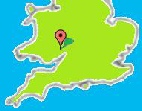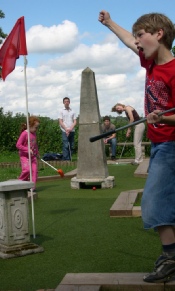









Open from 10:00 daily






Wye Valley MINIATURE GOLF
Now with two great 12-hole courses:
NEW Indoor ADVENTURE GOLF
Play on our unique course inspired by local legends surrounding King Arthur. Our course lies in the very shadow of the hill where Uther Pendragon first met Vortigern’s wizard Merlin.
You’ll be playing indoors from Merlin’s Sword in the Stone to the Kings Thorn and the Grail. Keep your eyes open and you might spot the red and the white dragons, the crown of Arthur and Robin Redbreast.
Find out about the local legends HERE
Outdoor MINIATURE GOLF
A roman ruin fantasy set in spectacular scenery in the Wye Valley, inspired by roman remains found further up White Brook and on the other side of the River Wye.
An outstanding outdoor course with all-weather artificial-turf fairways. The design unites a picturesque roman ruin theme, retro minigolf style and adventure golf features for ultimate playability for all ages.
Everyone loves the challenge of minigolf, and this course is a real leveller so you never know who’ll win. Where else can children beat their parents with a club in a fair contest?
Soft or short putters are available, so that even a toddler can play.
The local legends which inspired us originated around 1,500 years ago
The Sword in the Stone
Uthr Pendragon must have captured Myrddin, King Gwrtheyrn’s wizard, on our nearest hill when he and Ambrosius Aurelianus vanquished the proud tyrant there. Myrddin later used magic to disguise Uthr as the Duke of Cornwall so as to win the love of Eigyr, the Duke’s wife. Thus Arthur was born at Tintagel. Myrddin arranged his adoption, then twelve years later, got him accepted as Uthr’s heir when the boy withdrew a sword from an anvil and stone. After Arthur’s coronation at Caerleon his guests went out to play a game hitting balls with sticks. Adventure Golf, everybody?
King Arthur’s Hall
The cave on that hill was said to be linked by a secret passage to Merlin’s Cave, a mile away. King Arthur’s cave looks across a saddle towards Caer Guorthegirnus - Gwrtheyrn’s fort (he’s called Vortigern in English). The hill is named The Doward from Llandougarth, meaning “enclosure of two enclosures” – which exactly describes the fort’s layout. Arthur appointed Prince Bedwini of Llandougarth to be his bishop at Gelliwig near Caerwent.
Stonehenge
Ambrosius sent Uthr to win a trophy from the Irish for invading Britain, a sacred circle of stones. Merlin’s magic moved the stones from “Ireland” to Salisbury Plain. The tale may express folk memory: The stones were in fact quarried at Rhos-y-felin and Carn Goedeg in Preseli, Dyfed (where the Irish had invaded) and erected near the Carn at Bedd Arthur (Arthur’s Grave) about 4,500 years ago. Five hundred years later they were transported - through our village according to current theory - to Stonehenge, along with an altar-stone from Bannau Brecheiniog.
Merlin’s Cave
Merlin fell in love with Lady Vivianne of the Lake. The elf agreed they could live together underground if he taught her all his magic. She put him right off her by dint of magic words tattooed on her groin. He went mad, so she chained him up in the cave. He put off giving her his spell to put people to sleep by teaching other spells. Thus the two who’d used magic to help Uther and Guinevere break their vows ended up trapped together in a living purgatory by their own reneging of vows. BUT local rumours spoke of a secret escape tunnel to King Arthur’s Hall. Merlin must have escaped because it’s said that Mynydd Ferddin near Longtown is his burial mound.
Harmony of the Britons
Dyfed, Glwysing, Gwent, Kerniw and Ergyng (“’twixt Severn and Wye”) were united under King Meurig the Half-Dead (he was chronically ill and had to be carted into battle). He was the son of St. Tewdrig of Tintern who died at Mathern near Gelliwig and was the father of King Athrwys. Conflation of the exploits of these three real kings is the likely seed of the narrative behind the fictional King Arthur.
Gildas the Wise
The priest ranted from his pulpit about the five kings of the Britons for their part in the ruin and conquest of the Britons. He didn’t name Arthur, who had killed his brother, but raged about Arthur’s heir, Constantine of Cornwall. He called him “the tyrannical whelp of the unclean lioness of Damnonia”. This jeremiad sermon - De Excidio et Conquestu Britanniae – is the sole surviving historic record written in the Arthurian period.
Saint Constantine
King Arthur and Mordred mortally wounded each other at Camlann. Arthur trusted Constantine to be a good king, and gave him his crown as he lay dying. But King Constantine hunted Mordred’s sons down, killing one at prayer in a church, and the other in a monastery. Constantine repented these sins and became a monk at Hentland in Goodrich. He had the ford between Goodrich and Walford built, but he was soon murdered by Mordred’s allies. He was honoured by a burial at Stonehenge with Ambrosius, Uther and Uther’s brother Constance - all leaders of the war against the invasions by Picts, Irish and Saxons.
Arthur’s Stone
The young Arthur had a fight with a giant on Merbach Hill near Dorstone, during which the quoit-stone was dented. The giant may have been Rein, whose fort - Caer Rein - was on Aconbury Hill overlooking Hereford. Rein challenged Arthur after the upstart youth had humiliated kings Peibiaw The Dribbler of Erging and his brother Nyniaw of Ewyas by yoking them to plough like oxen for going to war over sheep on the Black Mountains. Arthur took the vanquished Rein’s mantle – made from the beard-pelts of the giant’s defeated enemies - as a trophy to wear at his coronation at Caerleon, where he was crowned by Dyffrig, grandson of Peibiaw and now Patron Saint of this parish (St. Dubricius in Latin). Dyffrig may have taken offence - he promptly resigned and wisely became a hermit on Bardsey.
The Kings Thorne
The royal Stuart dynasty believed themselves to be descendants of Arthur, and so styled themselves “Arthur Redivivat”. Charles I used Arthur’s Stone as a dining table in 1645. A sprig of The Holy Thorn was given to him by the monks of Glastonbury at Christmas. The Kings Thorne was planted near The Castle Inn at Little Birch on Aconbury hill (owned by the Duchy of Cornwall), hence the names of The Thorn and Kingsthorn districts nearby. It flowered on Twelfth Night (“Old Christmas”) and around Easter for three and a half centuries after The Regicide of Charles the Martyr. This “Blowing of the King’s Thorne” was celebrated by royalists and Catholics after The Restoration of the Monarchy. The Holy Thorn from which the scion came had sprung from the staff of Joseph of Arimathea, a tin trader who’d brought relics of Jesus of Nazareth to Britain. This legend explains William Blake’s lyrics of the hymn “Jerusalem”.
The Quest for the Holy Grail
Herefordshire police went on a fruitless quest for The Holy Grail in 2014 after it was stolen from Weston-under-Penyard. A woman there was Custodian of Cwpan Nanteos – a mazer bowl saved from Strata Florida by it’s monks. It was believed to be the Holy Grail, the cup used by Jesus at The Last Supper. It had been brought to Britain by Joseph of Arimathea after he’d arranged the funeral of Jesus. Drinking from it was claimed to cure disease. The Dingestow Brut manuscript tells that Eigyr, Arthur’s mother, was a descendant of Joseph’s sister and her grandfather had been Custodian of The Grail, which explains King Arthur’s obsession with finding the lost relic. Cwpan Nanteos was handed in anonymously after eleven months and is now curated by the National Library of Wales.
We hope you’ve enjoyed this legendary romp.
Go to TOP